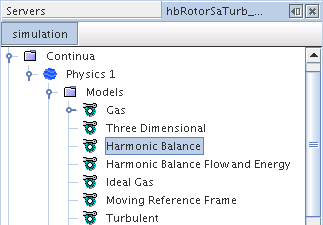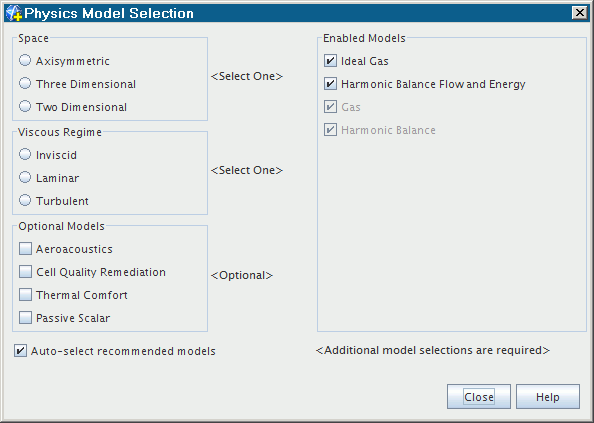Harmonic Balance Model
The Harmonic Balance model is represented in the object tree by the Harmonic Balance node, and is activated in the physics models selection dialog.

Activating the Harmonic Balance Model
To activate the Harmonic Balance model:
- In the
Physics Model Selection dialog, select the
Harmonic Balance model in the
Time group.

If the Auto-select recommended models checkbox is ticked, the Harmonic Balance Flow and Energy model is selected automatically.
When the Harmonic Balance model is selected, the standard Coupled Flow or Segregated Flow models cannot be selected.

The Implicit Harmonic Balance Solver is a coupled solver that couples the conservation of mass, momentum, and energy at all the time levels. Time levels are points in time, which are chosen by the solver, when a solution is computed.
The Harmonic Balance model works only with the following models within their respective categories:
- The Harmonic Balance Time model
- The Gas Material model
- The Ideal Gas Equation of State model
- The RANS K-Epsilon, K-Omega, and Spalart-Allmaras Reynolds-Averaged Turbulence models
From the other model groups, the Harmonic Balance method works with:
- Two-dimensional or three-dimensional models
- Stationary motion
- Reference Frame objects
- Inviscid, Laminar, or Turbulent viscous regimes
- The Passive Scalar model
When Simcenter STAR-CCM+ uses the Passive Scalar model with Harmonic Balance, it treats the passive scalars as steady and uses the time-mean harmonic balance solution (that is, quantities such as time-mean density, time-mean velocities, or time-mean turbulent viscosity) to solve the passive scalar transport equations. In other words, the passive scalars are transported within the solution domain using the time-mean flow field. Using the time-mean also implies that the passive scalar solution is unchanging over time.
You can also simulate blade vibration by selecting the Harmonic Balance Flutter motion instead of Stationary.